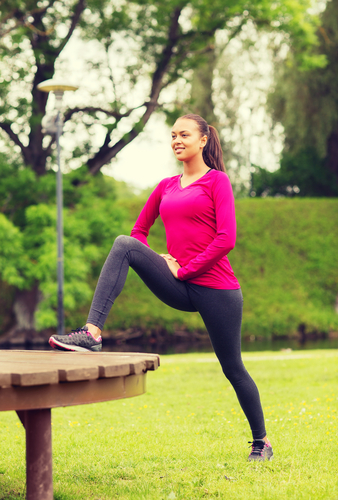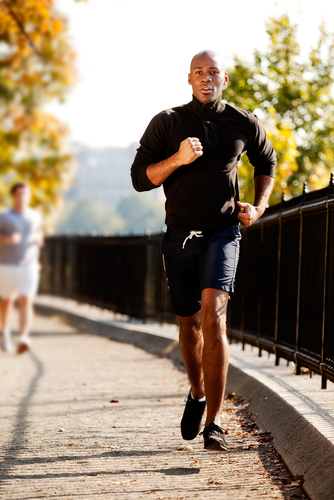By: Don Kern
Most of us have a lot going on, so running mega-miles every week in order to get stronger and faster isn’t always going to happen. However, if you have just a few minutes, you can squeeze in some of these workouts. Maybe try these right after one of your shorter mid-week runs or even while you’re waiting for favorite show to come on.
1. Get to the core of the matter. If your core muscles aren’t strong, your endurance will be compromised. Experienced marathon runners know that as you get into those higher miles and the fatigue sets in, your form starts suffering; your shoulders droop a little, your lungs are compressed and you don’t breathe as well as you did a few miles earlier. The weight of the finisher medal seems to pull your head down. If you experience that sensation, your core muscles aren’t supporting your body the way they should. This workout will help you improve your running form as your mileage increases.
The Workout: Rolling Planks. Start in a plank position, which is like a pushup position but resting on your elbows. Keep your body as straight as you can. This is the front position. Hold for 30 seconds. Now, without allowing your body to touch the ground, roll to your right side and rest on your right foot and right elbow for a side plank. Hold for 30 seconds. Go back to the front position for another 30 seconds. Then to the left side for 30 seconds. Now back to the center for the final 30 seconds. The total time is two minutes 30 seconds. Do this three times a week.
2. Building leg strength and turnover. Running long distances keeps you in the fat-burning zone for a long time, so if you don’t pay attention you can end up running slower. So take a few minutes, once a week, for this quick drill to increase your stride rate.
The Workout: Hill Blasts. Start with an easy warm-up run, then stand at the bottom of a hill that’s fairly steep. Run uphill as fast as you can for 10 seconds. Then walk backwards down the hill, focusing on recovery and stretching your legs on the way back down. Repeat 10 times. Do this for the 11th time and run hard up the hill for 20 seconds. Walk down backwards again. Total run time is 2 minutes and with the cool downs in between, you’re finished in less than ten. If you follow this workout with a jog on a flat road after, you’ll be amazed how easy it is to run. Make sure to jog enough to get your legs back to a relaxed state. 
Pro tip: Make sure to strike mid-foot instead of running on your toes during the blasts. Your calf muscles will thank you later.
3. Increasing leg speed. As a distance runner, sometimes you need to make sure that your legs “remember” what it feels like to go fast. Every couple weeks, throw this one into your rotation.
The Workout: Speed Bursts on a Track. Do a few laps on the track to warm-up your legs and lungs then start the bursts. In the straightaway sections, pick up your speed a few notches to just past your comfort zone and run hard for the full length. My training buddy Jim likes to call that speed “comfortably uncomfortable.” That means if you can talk while you’re at that speed, you aren’t working hard enough. At the curve, slow to recovery pace, even if that means walking for a little bit. As you approach the next straight, pick it up again and run until the next curve. On a 400-meter track, do five or six laps. On an indoor track, adjust the count accordingly, or alternate a hard half-lap with a recovery half-lap. Aim for five minutes total at the fast speed. After, run easy for a lap or two to cool down.
4. Building the Glutes. This exercise will benefit your hill climbing ability while strengthening and firming up your backside.
The Workout: Step-ups. Find a picnic table sitting on level ground. Step on the bench, then on the table and bringing your feet together. Then step back down to the bench and to the ground and bringing feet together. That’s one repetition. Alternate your leading foot on each repetition, or start with your right leg five times, then with your left leg five times. Reach the top of the table 20 times before you stop.
5. Quads and Abs. A long run is one continual progression of lifting one leg after another, so working on the leg lifting muscles is very important.
The Workout: High Knee March. Start slow, then fast. Stand in a normal posture and walk in place, lifting each knee a little higher than it takes to make your upper leg parallel to the floor. Swing your arms as if you are walking at the same time. For your first couple sessions, stand close enough to a wall so you can reach out and balance yourself if you need to. When you get to 100, 50 on each leg, you’re done. It’s a long way to 100 the first few times you do this but it will get easier each time.
Catch your breath—we’re not done yet. Second time will be the same as the first except much faster. Repeat the exercise, but at double time. Do 100 lifts, and make sure your knee comes up as far as it’s supposed to the whole time. The good news is that the second time goes much faster than the first time.
6. Building the Endurance. Short blasts are good for building endurance, so it’s a good idea to ramp it up
The Workout: High Intensity Interval Training. Get a warm-up in so your legs and breathing are ready for this. Find a flat, or even a slightly downhill stretch and sprint for 60 seconds. Turn around and walk back to the start. Keep a mental note of how far you got — or drop a rock or a stick to keep track. Repeat five times. Try to get at least as far as the previous spot on each succeeding sprint. Work your way up to repeating 10 times. Be sure to rest to fully recover after each one.
7. Day After Day Stamina. If you’re preparing for a multi-day event, it’s important to train many days in a row. The good news is, it’s not that difficult. Runner’s World ran a challenge at Thanksgiving, encouraging runners to run at least one mile every day from Thanksgiving to New Year. Since I was signed up to run a challenge of running seven marathons on seven continents in seven days, doing some running every day seemed like a good idea.
The Workout: Run a Mile Every Day. For a couple months run at least one mile every day. Your normal runs, if over a mile, are included. But on any day that would have been an off day, go run a mile. Even if it’s on a treadmill or taking two laps around the block. Keep your legs working every day for a while. 
8. Work Out No Matter What.This might be the hardest one. There are some days you just don’t feel like working out and that’s normal. This easy drill will change your attitude toward today’s workout
The Workout: Tie your shoes. Just throw on a pair of shorts and put on your running shoes. Take one step out the door and that’s it. Very small actions make very big changes in attitude. You will be amazed, and you’ll be running.
These tips are not too complicated and don’t require a gigantic effort. Rotate some of these into your regular routines and before you know it, you’ll see the improvements.
About the Author: “Marathon” Don Kern is a marathon race director, a veteran of more than 300 marathons, and a former Guinness World Record holder for running marathons on seven continents in the shortest period of time.


